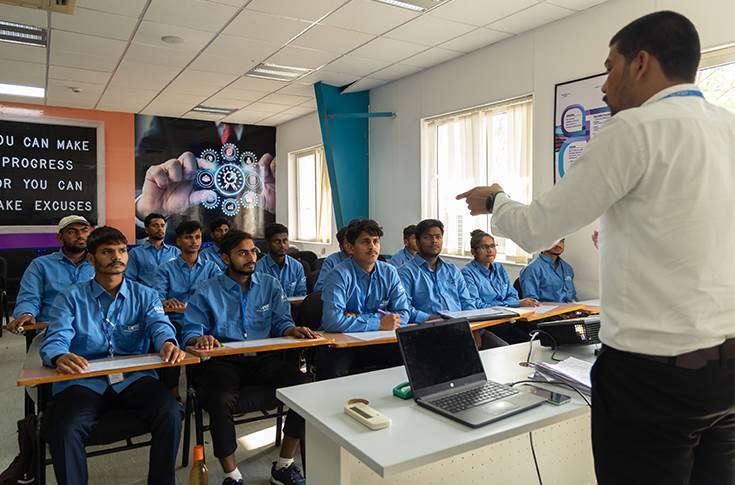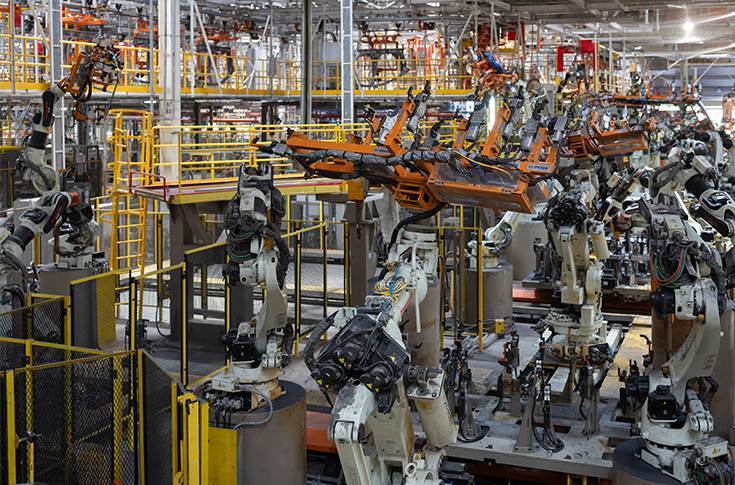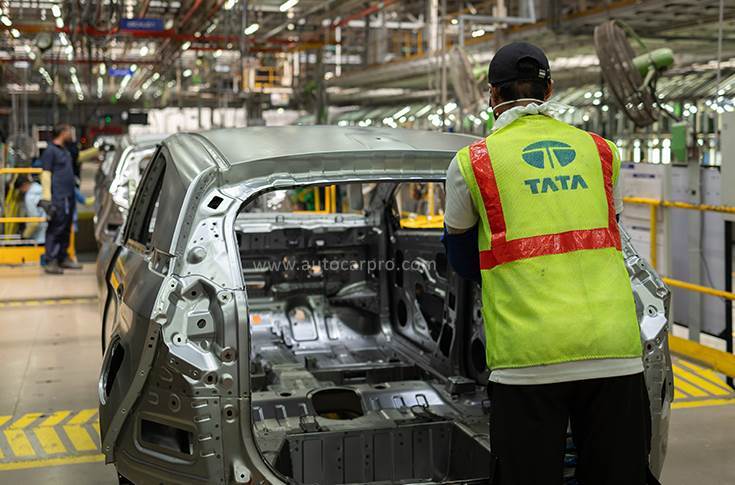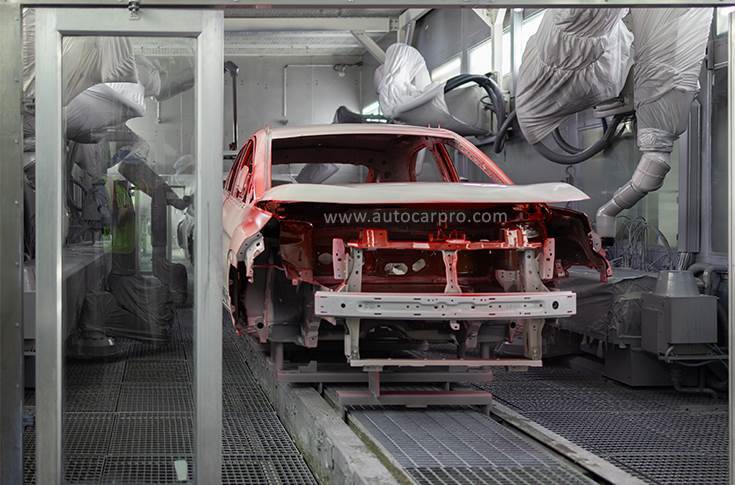It’s no secret that in 2015 when Ford inaugurated its USD 1 billion car state-of-the-art manufacturing unit in the GIDC industrial hub, Sanand, Gujarat, it represented a milestone in automotive manufacturing set-up in the country. Located around 23 km from Ahmedabad and spread across 460 acres, the factory was scientifically and aesthetically designed with best practices and sustainability in mind – be it sheet metal stamping, body construction, engine shop, paint, or final assembly areas. All these work areas were equipped with a varying level of automation and cutting-edge technology, to ensure precision and quality manufacturing of cars.
Ford began making the under 4m models like the Ford Figo, Ford Aspire and Ford Freestyle from this unit. However, things came to a crunching halt as part of its India restructuring plan, Ford decided to discontinue manufacturing vehicles (both domestic and export) and wound down the Sanand vehicle assembly plant by the fourth quarter of 2021.
For Tata Motors at the time, it could be seen as accident of timing as the priority was to increase capacity as the existing plants were running at their peak. In fact, demand for some models outstripped supplies, resulting in waiting periods.
As Ford was leaving India, in 2022, Tata Passenger Electric Mobility Ltd (TPEML), a subsidiary of Tata Motors Ltd, and Ford India Private Ltd (FIPL), entered a Memorandum of Understanding (MOU) with the Government of Gujarat (GoG) for the potential acquisition of FIPL’s Sanand vehicle manufacturing facility including land and buildings, machinery and equipment and transfer of all eligible employees of FIPL’s Sanand unit.
The deal went through smoothly and Tata Motors was able to acquire the Ford Sanand plant for Rs 725.7 crore. The buyout not only secured an asset but also resulted in savings totalling around Rs 5,000 crore for Tata Motors besides saving a lot of time for setting up a new factory of this magnitude from ground up.
The assets were officially handed over by Ford India to Tata Motors on January 10, 2023. Wasting no time, the Tata team went into action with an extensive plan for the repurposing and recommissioning of the plant with various production objectives and targets in mind. TPEM has invested over Rs 1,300 crore in the re-tooling of the plant and the extensive repurposing included upgrades to the robots and automation processes over each of the four plants – stamping, body construction/assembly, paint and final assembly. Several of the Tata Group companies like Tata Technologies, Tata Consultancy Services and JLR were involved in the revamp exercise along with other vendors. With these efforts and precision planning, TEPM was able to ensure flawless execution before time of the Sanand plant.
Operating through inverted pyramid model
As the deal included absorbing ex-Ford employees, TPEM used the inverted pyramid method in addressing the HR issues in an innovative and practical way to ensure the new workforce across technical and non-technical domains were ready as the recommissioning processes were taking place. Special focus was made in the production, maintenance, engineering, and quality functions.
The ex-Ford employees who were onboarded were also retrained and opportunities to enhance individual learning landscape was offered during the gestation period under a specially curated programme.
 Technicians undergoing class room teaching for enhancing skills.
Technicians undergoing class room teaching for enhancing skills.
Since the plant was to cater to various powertrains – mainly ICE and EVs, TPEM offered the new hires free of cost higher education programme in conjunction with on-site university called Nalanda. The curriculum focused on hands-on job training, EV capabilities, Six Sigma (Green belt) – CESS Level 2, 3 and Six Sigma (Master).
Meanwhile, all shop floor employees at various levels went through higher education programmes — a first in the industry. This was done through Nalanda, an in-house training facility that’s supported by faculty from Ganpat University.
Interestingly, all the employees at the Tata PEM plant hold a degree and are encouraged to go for higher education at company expense with no riders attached. For instance, those who have completed a course from an ITI are eligible for a Diploma course, those with a Diploma are eligible for a B. Tech degree. Those with a B. Tech, are eligible for the M. Tech course and so on.
Retooling and tech upgrades for specific Tata Motor PVs
 The plant is hugely automated and robots play a big part in production of cars.
The plant is hugely automated and robots play a big part in production of cars.
Since the existing set-up was designed for Ford ICE models, Tata Motors had to rejig the set-up extensively for their models like the Nexon and future models which are both ICE and electric. Set-up of any automotive manufacturing setup is dictated by the vehicle footprint, including its length, width, and body weight.
“The Sanand unit was already capable of manufacturing larger vehicles (by Ford). This automatically comes in handy and becomes useful for us to produce such EVs from there,” Anand Kulkarni, Chief Product Officer, and Head of High-Voltage Programs, TPEM.
For the press shop, 54 new stamping dies for body parts were required and model specific blanking dies were made for panels. The welding work area where various parts come together, is mostly automated with robots and camera detection capabilities for defects. Ninety new robots were added out here, and the existing 468 robots were modified as well. Since there are no forklifts on the shop floor, an overhead conveyor system is used to transport parts, and the 473 carriers also underwent modifications along with grippers and other tools.
For a customer, fit and finish are important in any premium product and the paint shop therefore plays a vital role out here and so do the 16 check points entrusted to ensure it happens as programmed in other areas of the assembly line.
Starting point
 High-tech cameras, gauges and jigs ensure tolerances of assembled components are perfect.
High-tech cameras, gauges and jigs ensure tolerances of assembled components are perfect.
For a visitor, the first sight that welcomes you in the factory is a convoy of body shells moving slowly towards the assembly area. That step comes much later.
The roll of steel coils is where it all begins and it’s also the noisiest section in the plant. After the material is checked thoroughly for thickness, integrity and other parameters, blanks are cut and workers manually feed the blanks that are shaped by hydraulic stamping machines and the dies used determine the shape of the part. Once done, the part goes to the trimming section where excess material is shaved off.
 Checking the panel gaps with special tools.
Checking the panel gaps with special tools.
Since product build quality, fit and finish are priority areas, there are stringent checks and various points at each level of the assembly. Each and every component is checked for dimensions and tolerances using techniques similar to ultrasonography. This highly sophisticated apparatus is capable of spotting manufacturing defects inside the components.
 All nooks and crannies are inspected at each station.
All nooks and crannies are inspected at each station.
With many loose body parts, its like assembling a jig saw puzzle. The automated welding shop is where the floor pan, firewall, side structures and roof are spot welded into place. Yes, there’s a specific sequence to this aspect — the side frames are welded to the floor first followed by the roof. A model specific jig is used to ensure all the parts fit and are aligned to the last millimetre accurately. Laser and cameras are employed to guide the process. This section of the build has highest level of automation in the plant – around 98%. At this stage the welded structure begins to resemble a car – in this case a Nexon. Once the work by the robots is complete, the doors, bonnet and hatch are added to the shell by the technicians.
Paint shop
 The state-of-the-art paint shop boast automated processess for exterior and interiors.
The state-of-the-art paint shop boast automated processess for exterior and interiors.
With most of the metal work done, the shell heads off to the paint shop. TPEM is continuing Ford’s innovative three-wet paint process that allows three coats of paint to be applied and dried simultaneously as it is energy efficient. The process significantly reduces wastage, energy consumption and helps in lowering paint shop carbon-dioxide emissions by up to 25 percent. The whole enclosed set-up is climate controlled – that is working temperature and humidity are kept consistent irrespective of the weather conditions outside.
Before paint process can even begin, the body in white (BIW) is dipped into the RoDip electrocoating tank. Here the machine tumbles the body 360° as it travels through the tank to deliver corrosion protection in all nooks and crannies before being despatched to the paint booth.
For the exterior of the vehicle, the robots use a 3-wet topcoat paint process which eliminates the need for a separate primer oven. Till now, the interior parts painting was done manually, but Tata Motors have taken this process to the next level by programming robotic spray paint machines to do the job. Forty robots are dedicated for this job and the shell spends a couple of hours in the chamber and with 50% automation, the paint shop has clearly demarcated areas that are run either entirely by robots or entirely by technicians. And before the body leaves paint shop, there’s another round of thorough physical examination. Any flaws or blemishes on the paint work is corrected out here manually.
The paint shop set-up is designed and programmed in such a way that it doesn’t have to depend on batch jobs – a run of single colours and is flexible enough to carry out two tone paint jobs as well. In this case, the body shell is masked manually and resent to the paint chamber.
The next step in the process is to reach out to those areas where additional corrosive protection is absolutely needed. A special gravity-based angled ramp ensures that injected wax oils reaches out to all corners, while silicon sealing is done for the joints manually.
Trim, chassis and final assembly
Trim, chassis and final assembly or TCF is the area where both technicians and machines work together on the painted shell that arrives to the dedicated station via conveyor. The interesting fact is that in the chassis assembly area where the powertrain is married to the chassis and the system is so flexible that it can accommodate random ICE (petrol, diesel, CNG) engines randomly. At the same time other hardware like suspension, steering assembly, brakes and wheels are affixed by the technicians.
 This is where the marriage of the powertrain and chassis takes place.
This is where the marriage of the powertrain and chassis takes place.
This is a significant time saver for models like the Nexon that comes as an ICE or EV model. The trim section is where most of the worker activity is noted as a model like Nexon has 96 variations when it comes to trims. The next stage includes a variety of jobs like placement of the front and rear windscreens, laying out the wiring harness, fixing the dashboard, seats, roofliner, doors and door cards, handles among others.
After the trim jobs are completed for both exterior and interior, the ICE models are tanked up and engine is started and checked for codes. Likewise, for the EVs, a host of protocol checks are performed for the various powertrain components and battery charging systems.
Final inspection
 Paint defects, if any, are manually corrected with special processes and machines.
Paint defects, if any, are manually corrected with special processes and machines.
Before the completed car is shipped out from the factory, it goes in for wheel alignment, castor and camber adjustments, a shower check for water leaks before it enters the final inspection chamber for ABS and ADAS testing.
Production ramp up
TPEM has efficiently transformed the ex-Ford unit it to suit their manufacturing needs, particularly focusing on producing models like the Nexon and adapting the setup for both internal combustion engine (ICE) and electric vehicles (EVs).
 After assembly, the new car is checked for systems, alignment, braking, ABS etc.
After assembly, the new car is checked for systems, alignment, braking, ABS etc.
At present 300-330 cars roll out of Sanand on a single shift, and it takes about 16 hours to build a car. Over the coming months, measures are being taken to ramp up production in phases. The annual plant capacity is 300,000 units and can be ramped up to 420,000 units.
Sustainability
In line with Tata Motors’ commitment to sustainability, 50 KW solar rooftop is installed in the plant. This is a water neutral plant and is expected to be water positive by December 2024. Other examples of environment-friendly measures in place at the plant include zero waste to landfill, natural gas for ovens and rainwater harvesting. In fact, the Sanand plant has been designed to achieve zero wastewater discharge status.
This feature was first published in Autocar Professional’s June 15, 2024 issue.
